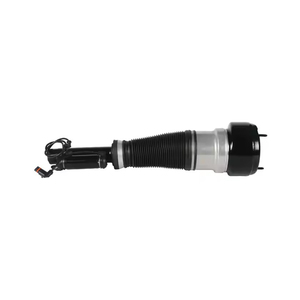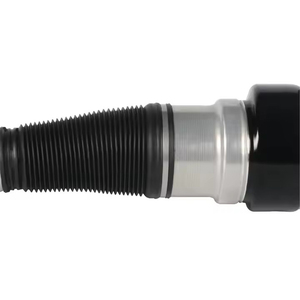
All categories
Featured selections
Trade Assurance
Buyer Central
Help Center
Get the app
Become a supplier

(4703 products available)


















































An air suspension universal kit replaces a vehicle's steel spring suspension with a system of air-filled rubber bags (bladders) called ""bags"" instead of struts. The bags inflate and deflate using an onboard air compressor and air lines. This allows for a smoother ride and better handling. An air suspension kit can be fitted to the front, rear, or all four corners of a vehicle. There are two main types of air suspension kits available: aftermarket air suspension kits and factory air suspension kits. The former is further divided into several types as detailed below:
The specifications of an air ride suspension kit can vary depending on the specific kit and manufacturer. However, some common specifications that might be included in an air suspension universal kit are as follows:
Spring Bag Size
Spring bag diameter: 6, 7, 8 inches or more
Spring bag height: 12, 14, 16 inches or more
Shocks Size
Shock absorber length: 10, 12, 14 inches or more
Shock absorber diameter: 2, 2.5, 3 inches or more
Compressor Size
Compressor airflow rate: 1.5, 2.5, 3.5 CFM or more
Compressor pressure: 100, 120, 150 PSI or more
Tank Size
Tank volume: 2, 3, 4, 5, 6 gallons or more
Tank pressure: 100, 120, 150 PSI or more
Control System
Digital control panel with LCD display
Wired or wireless remote control
Pressure sensors for bag and tank monitoring
Height sensors for automatic leveling
Mounting Hardware
Bolts, nuts, washers, and other fasteners
Brackets for mounting bags, shocks, compressor, and tank
Airlines, fittings, and adapters
Maintaining an air suspension system is essential to ensure its longevity and optimal performance. Here are some general maintenance tips for an air suspension system:
Regular Inspection
Inspect the air bags, hoses, and other components for any signs of wear, damage, or leaks. Check for cracks, punctures, or tears that could compromise the system's integrity. Look for any signs of moisture or oil contamination, which could weaken the materials. Inspect the shock absorbers for any signs of leakage or reduced performance. Uneven tire wear or handling issues may do this.
Cleanliness
Keep the air suspension components clean and free from dirt, debris, and contaminants. Use mild soap and water to clean the bags and other parts regularly. Avoid using high-pressure washers or abrasive cleaners that could damage the materials.
Air Filter Maintenance
If the air suspension system has an air filter, inspect and replace it as needed. A clean air filter helps prevent dirt and debris from entering the system, prolonging its life.
Proper Inflation
Check the air pressure in the bags regularly and ensure it meets the manufacturer's specifications. Under-inflation or over-inflation can affect ride quality, load capacity, and component wear. Use a reliable pressure gauge to measure the bag pressure, and adjust it as needed using the onboard compressor or external source.
Regular System Check
Periodically, perform a complete system check. Ensure that the compressor functions correctly and maintains the required pressure in the bags. Listen for any unusual noises or operation issues. Inspect the pressure switch, relay, and other electrical components for proper operation. Check the wiring harness for any signs of damage, corrosion, or loose connections.
Load Management
If the vehicle has a load-carrying capacity, avoid exceeding it. Carrying excessive loads can strain the air suspension components and lead to premature failure. Distribute the load evenly across the vehicle to ensure optimal performance and stability.
Wholesale buyers must understand the factors to consider when purchasing air suspension kits. Here are the factors in detail.
The Vehicle Make and Model
When selecting an air suspension system, the vehicle's make and model are essential considerations. This is because different vehicles use different suspension systems. Find out the compatible air suspension universal kits with the specific vehicle make and model.
The Load Capacity of the Suspension Kit
Different air suspension kits have various load capacities. Business buyers should select kits that can handle the loads transported by the vehicles without compromising performance.
The Adjustable Height Range
Some air suspension kits have a higher adjustable height range than others. Business buyers should choose kits with a height adjustment range that suits their needs. For instance, if they have a sports car that needs more height, they should select an air suspension universal kit with a greater height adjustment.
The Type of Air Suspension System
There are different types of air suspension systems. For example, some kits use double wishbone systems, while others use a strut-based system. Buyers should select a system that suits their needs and preferences.
The Quality and Durability of the Components
Buyers should select air suspension kits with high-quality components. The quality of the components will ensure that the suspension system is durable and reliable.
The Ease of Installation and Maintenance
Business buyers should choose air suspension kits that are easy to install and maintain. Some kits require professional installation, while others can be installed DIY.
The Price of the Air Suspension Kits
There is a price difference between various air suspension kits. Buyers should set a budget and shop for a kit that offers value for money. They should also avoid super cheap kits because they may have inferior quality components.
Replacing the air suspension universal kit can be a complex task, but it is feasible with the right tools, materials, and mechanical knowledge. Here is a step-by-step guide on how to replace the air suspension universal kit:
Tools and materials needed:
Step-by-step guide
Q1: Who needs an air suspension universal kit?
A1: Generally, a suspension kit is useful for people who want a comfortable ride. More specifically, a universal air suspension kit is for drivers of large vehicles such as trucks and vans. It is also suitable for luxury vehicles. The suspension kit is ideal for off-road drivers and people living in areas with poor road conditions. Ultimately, the air suspension universal kit is for people who want to upgrade their existing suspension system.
Q2: How can people know that their suspension needs replacement?
A2: Replacing the suspension system can be costly. As such, it is important to evaluate the system before making any decisions. Visual inspection can reveal leaks and cracks on the suspension components. Also, if the vehicle bounces excessively on the road or the ride height is uneven, it could be time to replace the suspension. Other signs include the vehicle pulling to one side and difficulty steering.
Q3: Can an air suspension universal kit be installed in any vehicle?
A3: The air suspension universal kit can be fitted into many vehicles, especially those with coil spring suspensions. However, not all vehicles are compatible with the suspension system. Air suspension kits are best suited for heavy load vehicles such as trucks and buses. They are also ideal for luxury vehicles. Consult the manufacturer or a mechanic to determine whether a vehicle can use the suspension kit.
Q4: What are the benefits of installing an air suspension universal kit?
A4: The air suspension universal kit has many benefits. It improves the vehicle's overall performance, offers a smoother ride, and increases driving comfort. The vehicle becomes more stable, especially when driving at high speeds or when carrying loads. The driver has more control over the vehicle, reducing the chances of accidents. The ride height can be adjusted, making it easier to load and unload goods. Ultimately, the air suspension universal kit adds value to the vehicle.